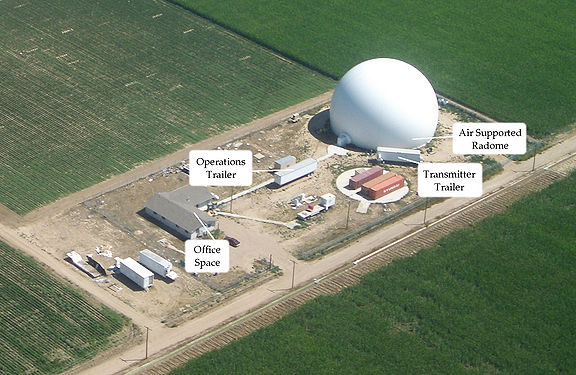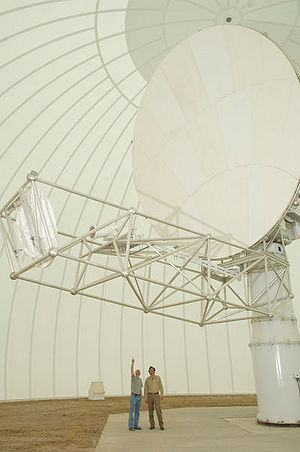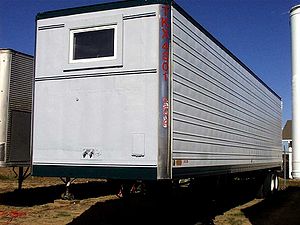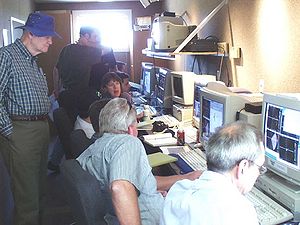CSU-CHILL S- and X-band: Difference between revisions
(Created separate page for CHILL radar) |
(Added deployments list) |
||
| Line 14: | Line 14: | ||
[[Image:CHILL ops ext.jpg|center|300px|thumb|CHILL Operations Trailer, Exterior View]] [[Image:CHILL ops int.jpg|center|300px|thumb|Interior View, CHILL Operations Trailer]] | [[Image:CHILL ops ext.jpg|center|300px|thumb|CHILL Operations Trailer, Exterior View]] [[Image:CHILL ops int.jpg|center|300px|thumb|Interior View, CHILL Operations Trailer]] | ||
===Requesting Use of the Facility | ==Deployments== | ||
{{Main|[[CSU-CHILL Projects and Deployments]]}} | |||
CSU-CHILL has a long history of field deployments and projects in support of the scientific community. | |||
==Requesting Use of the Facility== | |||
Projects conducted at the facility can be classified into | Projects conducted at the facility can be classified into | ||
===Major Projects=== | |||
These projects usually involve moving the radar, larger time scales of observation (typically in excess of 20 hours) and requires the involvement and funding from the National Science Foundation (NSF). Please [[Contacts|contact the Scientific Director]] for details on requesting the use of the facility. | These projects usually involve moving the radar, larger time scales of observation (typically in excess of 20 hours) and requires the involvement and funding from the National Science Foundation (NSF). Please [[Contacts|contact the Scientific Director]] for details on requesting the use of the facility. | ||
===Cost-recovery=== | |||
These are larger projects that do not involve funding from the National Science Foundation. A daily use fee will be charged during the data collection process. Please [[Contacts|contact the Scientific Director]] for details on requesting the use of the facility. | These are larger projects that do not involve funding from the National Science Foundation. A daily use fee will be charged during the data collection process. Please [[Contacts|contact the Scientific Director]] for details on requesting the use of the facility. | ||
===20-hour Projects=== | |||
20 hour projects were conceived as a method to provide simplified access to the radar for users with specific data collection requirements that can be supported with modest facility effort, typically, no more than ~20 hours of radar operational time. 20 hour project investigators (and often their students) also gain valuable experience in the overall planning and conduct of meteorological field research activities. | 20 hour projects were conceived as a method to provide simplified access to the radar for users with specific data collection requirements that can be supported with modest facility effort, typically, no more than ~20 hours of radar operational time. 20 hour project investigators (and often their students) also gain valuable experience in the overall planning and conduct of meteorological field research activities. | ||
| Line 29: | Line 33: | ||
To request a 20-hour project, please Fill out the [https://docs.google.com/a/rams.colostate.edu/spreadsheet/embeddedform?formkey=dEN2ODlYaE1HenYzdHFyMDZLNGw2M2c6MQ Small project application form]. | To request a 20-hour project, please Fill out the [https://docs.google.com/a/rams.colostate.edu/spreadsheet/embeddedform?formkey=dEN2ODlYaE1HenYzdHFyMDZLNGw2M2c6MQ Small project application form]. | ||
==Technical Documentation== | |||
Technical details of the CHILL radar are described in the {{pdf|brochure_web.pdf|CSU-CHILL Technical Brochure}}. A more detailed description of the hardware and software architecture of CHILL is given in the [[hardware description]]. | Technical details of the CHILL radar are described in the {{pdf|brochure_web.pdf|CSU-CHILL Technical Brochure}}. A more detailed description of the hardware and software architecture of CHILL is given in the [[hardware description]]. | ||
Revision as of 01:58, 14 January 2024
CSU-CHILL
CSU-CHILL is a transportable dual-polarization radar system, with a 9 meter parabolic dual-offset reflector antenna. The radar features two S-band dual Klystron transmitters driving each polarization channel, and an X-band transmitter driving the two polarization channels. Each S-band transmitter develops approximately 1 MW of power, while the X-bands generate 25 kW. The transmitters are controlled by a flexible digital waveform generator, which can synthesize a wide variety of polarization states. The low-noise receivers are connected to a customized signal processing system, which can output various polarimetric moments. Moment data, as well as raw time series data can be archived for later study.

The radar site is located near Greeley, CO at latitude 40° 26' 46.5'' (N40.44625) and longitude 104° 38' 13.5'' (W104.63708), at an elevation of 1432 meters MSL.


The antenna is housed within an inflatable radome, for protection against wind loading and corrsion. The radome is constructed from low-loss microwave-transparent materials. The main radar hardware is housed within the radar trailer, which contains the transmitters, receivers and control subsystems. The digitized signals from the receiver are passed through fiber-optic cables to the operations trailer, which contains the Parallel Receiver signal processor and display workstations.


Deployments
Main article: CSU-CHILL Projects and Deployments
CSU-CHILL has a long history of field deployments and projects in support of the scientific community.
Requesting Use of the Facility
Projects conducted at the facility can be classified into
Major Projects
These projects usually involve moving the radar, larger time scales of observation (typically in excess of 20 hours) and requires the involvement and funding from the National Science Foundation (NSF). Please contact the Scientific Director for details on requesting the use of the facility.
Cost-recovery
These are larger projects that do not involve funding from the National Science Foundation. A daily use fee will be charged during the data collection process. Please contact the Scientific Director for details on requesting the use of the facility.
20-hour Projects
20 hour projects were conceived as a method to provide simplified access to the radar for users with specific data collection requirements that can be supported with modest facility effort, typically, no more than ~20 hours of radar operational time. 20 hour project investigators (and often their students) also gain valuable experience in the overall planning and conduct of meteorological field research activities.
20 hour projects have secondary priority to the support of NSF-allocated research projects. Their support is also contingent upon scheduled radar maintenance/upgrade activities and facility staff availability. 20 hour project expenses are currently provided by the facility’s NSF base funding.
To request a 20-hour project, please Fill out the Small project application form.
Technical Documentation
Technical details of the CHILL radar are described in the ![]() CSU-CHILL Technical Brochure
CSU-CHILL Technical Brochure  . A more detailed description of the hardware and software architecture of CHILL is given in the hardware description.
. A more detailed description of the hardware and software architecture of CHILL is given in the hardware description.